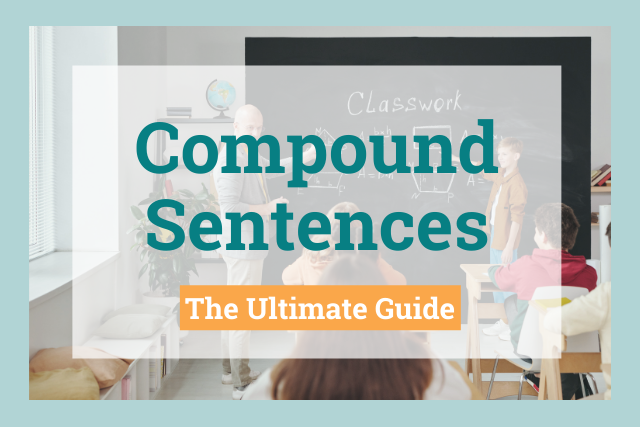
If you want to improve your writing, you’ll need to be able to construct many different types of sentences.
Understanding how to use compound sentences will help you vary the sentence lengths in your writing, which creates better flow and makes your writing sound more professional.
So what is a compound sentence? A compound sentence is a sentence with at least two independent clauses.
This article will explain how to construct a compound sentence and give you examples from literature.
What Is a Compound Sentence?
A compound sentence is a sentence that contains two or more independent clauses.
An independent clause is a clause that can be a grammatically complete sentence all by itself. (The alternative is a dependent clause, which can't stand alone.)
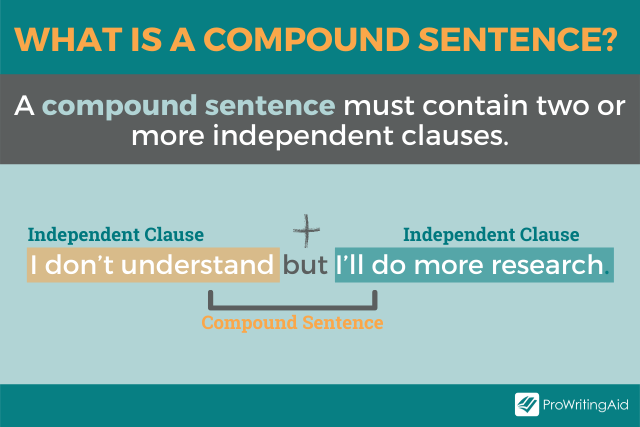
In other words, if you broke a compound sentence apart into pieces, you could create two or more grammatically correct sentences.
What Are the Conjunctions You Can Use to Join Two Independent Clauses Together in a Compound Sentence?
There are four ways you can join two independent clauses together:
- Conjunctions
- Semicolons
- Em-dashes
- Colons
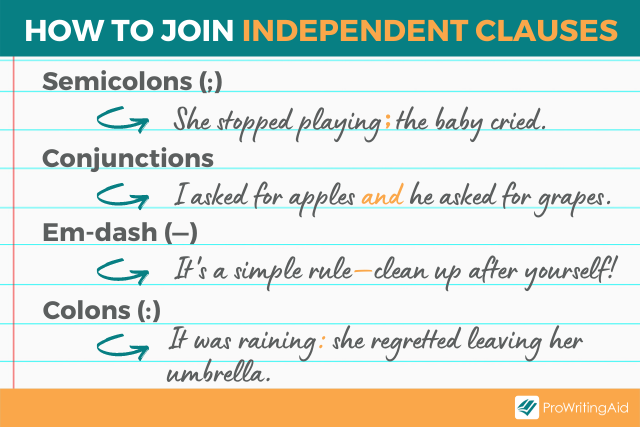
1. Conjunctions
The most common way to create compound sentences is to use conjunctions, preceded by a comma.
Conjunctions are words that tie clauses together. There are multiple types of conjunctions. Some can be used to create compound sentences, and some can’t.
The most common type is a coordinating conjunction: “for”, “and”, “nor”, “but”, “or”, “yet”, and “so.” (You can remember them using the mnemonic F.A.N.B.O.Y.S.)

Here are some examples of compound sentences with coordinating conjunctions:
- I asked for apple pie for dessert, and my sister asked for chocolate cake.
- I wanted apple pie for dessert, but my sister made us eat chocolate cake.
- We can have apple pie for dessert, or we can have chocolate cake.
Notice that in order to create a compound sentence, you need to include a comma before the coordinating conjunction.
The second type of conjunction is a correlative conjunction, which is used in pairs. The most common pairs are “either/or”, “neither/nor”, and “not only/but also.”
Here are some examples of compound sentences with correlative conjunctions:
- Either we will have apple pie, or we will have chocolate cake.
- Not only will we have apple pie, but we will also have chocolate cake.
There’s another type of conjunction called subordinating conjunction, these are “although”, “because”, “if”, “since”, “while”, and “unless”. However, these are used for dependent clauses.
If two clauses are connected with a subordinating conjunction, they make a complex sentence, not a compound sentence.
2. Semicolons
Another way to join two clauses together is to use a semicolon. This method creates a smoother transition between two sentences than a period.
Here’s an example from Exhalation by Ted Chiang:
- “But I’ve never prayed with the expectation that it would affect your actions; I prayed with the expectation that it would affect mine.”
3. Em-dashes
Another way to join two independent clauses together is to use an em-dash.
Here’s an example from This Is How You Lose the Time War by Max Gladstone and Amal El-Mohtar:
- “Adventure works in any strand—it calls to those who care more for living than for their lives.”
4. Colons
The rarest way to join two independent clauses together is to use a colon. Usually, colons don’t join independent clauses, they connect an independent clause to a dependent clause.
Here’s an example from New York 2140 by Kim Stanley Robinson:
- “It’s what economists used to call the tyranny of sunk costs: once you’ve put so much time and money into a project, it gets hard to just eat your losses and walk.”
What Is the Difference Between a Simple, Complex, and Compound Sentence?
There are four major types of sentence structures:
- Simple sentences
- Complex sentences
- Compound sentences
- Compound-complex sentences
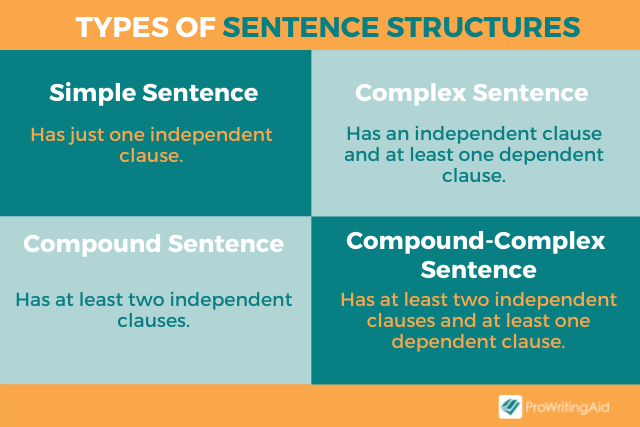
A simple sentence has just one independent clause.
- Example: There’s an oak tree behind my house.
A complex sentence has an independent clause and at least one dependent clause.
- Example: There’s an oak tree behind my house, which my brother and I used to climb when we were kids.
A compound sentence, as you already know, has at least two independent clauses.
- Example: There’s an oak tree behind my house, and I go there sometimes when I’m lonely.
You can also have a compound-complex sentence, which has at least two independent clauses and at least one dependent clause.
- There’s an oak tree behind my house, which my brother and I used to climb when we were kids, and I go there sometimes when I’m lonely.
You'll want to use different sentence structures to keep your audience engaged. ProWritingAid's Sentence Structure report can help with that.
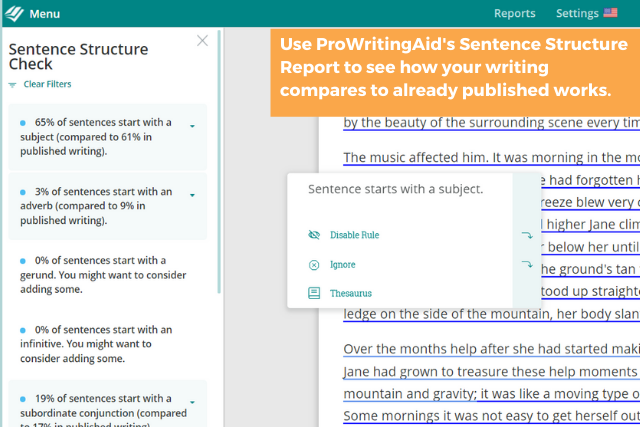
Use ProWritingAid's visualizations to spot where you need to vary your sentence lengths. Too many long sentences can be boring, while too many short sentences can feel unfinished or disjointed.
Try the Sentence Structure report with a free ProWritingAid account.
Before we look at some examples of compound sentences, review your knowledge with our video guide:
What Are Examples of Compound Sentences?
Let’s look at some examples from successful books. Some of these example sentences have only two independent clauses, while others have as many as eleven.
“Our mothers teach us to speak, and the world teaches us to shut up.” – Lost Children Archive by Valeria Luiselli
- First independent clause: Our mothers teach us to speak
- Conjunction: and
- Second independent clause: the world teaches us to shut up

“The explorer who will not come back or send back his ships to tell his tale is not an explorer, only an adventurer, and his sons are born in exile.” – The Dispossessed by Ursula K. LeGuin
- First independent clause: The explorer who will not come back or send back his ships to tell his tale is not an explorer, only an adventurer
- Conjunction: and
- Second independent clause: his sons are born in exile
“Peg’s smile remains in place, but it’s like a picture of a smile someone has hung on her face instead.” – The Scorpio Races by Maggie Stiefvater
- First independent clause: Peg’s smile remains in place
- Conjunction: but
- Second independent clause: it’s like a picture of a smile someone has hung on her face instead
“The sitting room is subdued, symmetrical; it’s one of the shapes money takes when it freezes.” – The Handmaid’s Tale by Margaret Atwood
- First independent clause: The sitting room is subdued, symmetrical
- Conjunction: semicolon
- Second independent clause: it’s one of the shapes money takes when it freezes
“Now I think it’s one of the most useless questions an adult can ask a child—What do you want to be when you grow up?” – Becoming by Michelle Obama
- First independent clause: I think it’s one of the most useless questions an adult can ask a child
- Conjunction: em-dash
- Second independent clause: What do you want to be when you grow up?
“In the moment, you have to pee, or your arm itches, or what people are saying strikes you as melodramatic or sentimental, and it’s hard not to smirk.” – Prep by Curtis Sittenfeld
- First independent clause: you have to pee
- Conjunction: or
- Second independent clause: your arm itches
- Conjunction: or
- Third independent clause: what people are saying strikes you as melodramatic or sentimental
- Conjunction: and
- Fourth independent clause: it’s hard not to smirk
“In the late afternoon, Saeed went to the top of the hill, and Nadia went to the top of the hill, and there they gazed out over the island, and out to sea, and he stood beside where she stood, and she stood beside where he stood, and the wind tugged and pushed at their hair, and they looked around at each other, but they did not see each other, for she went up before him, and he went up after her, and they were each at the crest of the hill only briefly, and at different times.” – Exit West by Mohsin Hamid
- First independent clause: Saeed went to the top of the hill
- Conjunction: and
- Second independent clause: Nadia went to the top of the hill
- Conjunction: and
- Third independent clause: there they gazed out over the island, and out to sea
- Conjunction: and
- Fourth independent clause: he stood beside where she stood
- Conjunction: and
- Fifth independent clause: she stood beside where he stood
- Conjunction: and
- Sixth independent clause: the wind tugged and pushed at their hair
- Conjunction: and
- Seventh independent clause: they looked around at each other
- Conjunction: but
- Eighth independent clause: they did not see each other
- Conjunction: for
- Ninth independent clause: she went up before him
- Conjunction: and
- Tenth independent clause: he went up after her
- Conjunction: and
- Eleventh independent clause: they were each at the crest of the hill only briefly, and at different times
Final Words
Now you know what a compound sentence is and how to identify each component of one.
Was this article helpful? Let us know in the comments.


